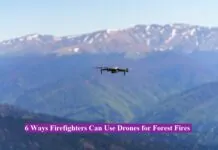When it comes to tackling forest fires, technology has emerged as a powerful ally for firefighters. Among the technological advancements aiding in this endeavor, drones have proven to be invaluable assets.
Spectrum Local News reports that firefighting drones can contain wildfires faster and safer. These unmanned aerial vehicles are equipped with various sensors and capabilities that make them indispensable in firefighting efforts.
Here are six ways firefighters can harness the potential of drones to enhance their effectiveness in combating forest fires.
Table of Contents
#1 Early Detection and Monitoring
One critical aspect of firefighting is the early detection of a potential fire outbreak. Drones equipped with infrared cameras and thermal imaging sensors can be deployed for round-the-clock monitoring of vast forested areas.
According to Oklahoma State University, modern drones can detect even the smallest heat signatures. This will allow firefighters to identify and address potential fire hazards before they escalate into full-blown wildfires. The ability of drones to cover large areas quickly and efficiently significantly enhances early detection efforts, providing crucial time for preemptive measures.
#2 Aerial Mapping and Situation Assessment
Forest fires are dynamic and fast-evolving situations. This makes it challenging for firefighters to get a comprehensive understanding of the terrain and the fire’s progression.
Drones equipped with high-resolution cameras and mapping software can provide real-time aerial maps, giving firefighters a bird’s-eye view of the affected area. This information helps incident commanders make informed decisions on resource allocation, evacuation routes, and strategic placement of firefighting teams.
Research published on ScienceDirect suggests that aerial mapping from drones can also aid in identifying potential escape routes for trapped people and wildlife. Firefighters can use these identified routes to coordinate rescue operations.
#3 Communication and Coordination
In the chaos of a wildfire, effective communication and coordination are paramount. Drones equipped with communication relay systems can establish and maintain connectivity in areas with compromised communication infrastructure. This is particularly crucial in remote or densely forested areas where traditional communication methods may be unreliable.
Drones can act as mobile communication hubs and facilitate seamless information exchange between firefighters on the ground, incident commanders, and other emergency response teams. This real-time communication enhances overall situational awareness and enables a more coordinated and effective firefighting response.
#4 Dropping Fire Retardants and Water
Drones equipped with payload release systems can be employed to drop fire retardants and water onto targeted areas. This capability is especially beneficial in areas that are difficult to access or where traditional firefighting aircraft may face challenges.
Drones can navigate through tight spaces, delivering precise and controlled drops of fire-suppressing agents. This not only helps in containing the spread of the fire but also minimizes the risk to firefighters operating in hazardous terrain.
The use of drones can also help firefighters avoid various health risks, especially when toxic firefighting foam is involved. In doing so, these drones can even save these front liners from cancer.
The most talked about case of firefighting foam usage leading to cancer was seen in the AFFF lawsuit. According to TorHoerman Law, the AFFF firefighting foam, containing forever chemicals, was causing cancer among the foam users. As a result, the AFFF cancer lawsuits were filed.
The AFFF firefighter foam cash settlements are around $40,000 to $300,000. This money, if awarded to the AFFF victims, will be used to compensate for their medical bills and other losses.
The AFFF lawsuits emphasize the need for safer firefighting foam. However, if such toxic foam needs to be used, it should be done through drones and not humans. Exposure to toxic chemicals won’t affect drones the same way they affect humans. Hence, they are ideal for dropping toxic foam over forest fires if needed.
#5 Search and Rescue Operations
In the aftermath of a forest fire, search and rescue operations become a critical component of the overall response.
Drones equipped with cameras and thermal imaging sensors can be instrumental in locating and identifying individuals in need of assistance. The aerial perspective they provide allows for more efficient surveying of large areas. This, in turn, helps rescue teams locate survivors and assess the extent of the damage.
Drones can also be used to survey road conditions and assess the safety of access routes for emergency vehicles. This helps in the timely deployment of rescue teams.
#6 Post-Fire Assessment and Environmental Monitoring
After a forest fire has been successfully contained, drones continue to play a vital role in the recovery phase. They can be deployed for post-fire assessment, surveying the extent of the damage, and identifying areas prone to potential secondary hazards such as landslides.
Drones can also be equipped with environmental monitoring sensors to assess air and water quality in the affected area. Such assessments help authorities to make informed decisions regarding the safety of re-entry for evacuated residents and the restoration of wildlife habitats. The data collected by drones during the post-fire phase contributes to a better understanding of the long-term environmental impact of wildfires.
Conclusion
The use of firefighting drones has been gaining momentum in the past few years. As evident from the discussion above, using these drones can provide first responders with a lot of benefits.
Hence, firefighters involved in dealing with wildfires need to be trained on how to make the most of these drones. This can help them mitigate the risks associated with handling wildfires while dealing with the situation itself more effectively.

















